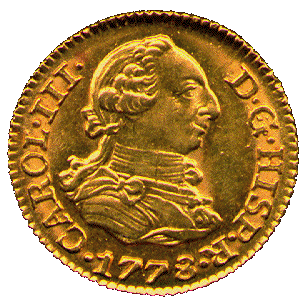 |
For the past ten years we could run ourselves ragged trying to counter the gold disinformation machine. For example, the lead story in the Markets section of today’s Wall Street Journal “Odd Couple: Stocks, Gold Share Same Ride Higher” begins:
As the world begins recovering from the worst financial crisis in 70 years, an odd couple of winners have emerged: stocks and gold. So far this year, the Dow Jones Industrial Average, a bet on economic recovery, is up 14%. Gold futures, a bet on calamity, are up 19%. The reason: Low interest rates and heavy government stimulus have poured cheap money into financial markets, helping both the economy and stocks. But the creation of all that money, together with the Federal Reserve's maintenance of near-zero benchmark interest rates and the prospect of heavy government borrowing to fund deficits, threatens to weaken the dollar and fuel inflation and economic volatility later.
Let’s look at the key assertions in this opening paragraph in the context of actual data, the price of gold and of the S&P over the past ten years since iTulip opened shop and we started buying gold. We also correlate the data with the political economy of the FIRE Economy that drives gold and stock prices. Are rising gold and stock prices unusual?
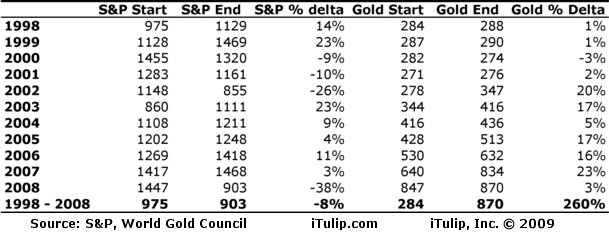
Here are the facts.
- The S&P finished higher in only six out of the past ten years.
- In three out of the four years that the S&P finished lower, gold finished higher.
- Each year for the last ten years the gold price has finished higher than the year's starting price, except for the year 2000 when gold prices fell 3%.
- Even in the year 2000, the year in the past ten that gold prices fell, gold prices fell less than 1/3 as far as stocks fell.
- Gold performed worse than the S&P during the stock bubble years of 1998 and 1999 when the S&P gained 14% and 23% respectively. Even so, gold prices went up 1% in each of those years.
- The S&P gave it all back and more from 2001 to 2002 when stocks fell 10% then 26% while gold prices increased 20% then 17%.
- In total over the ten year period, gold prices went up 260% compared to a loss of 8% for the S&P.
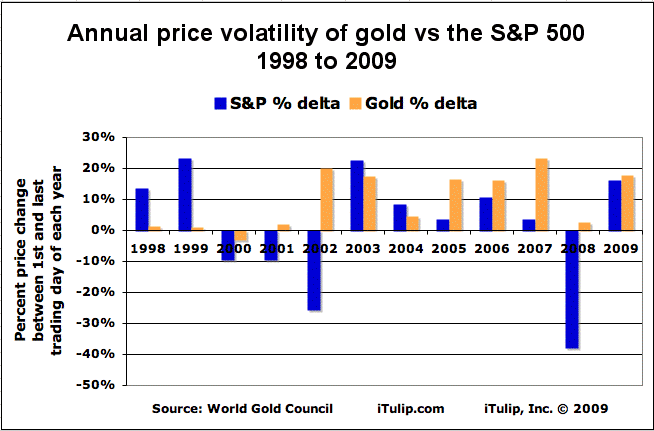
So far the reflation rally of 2009 is looking similar to the reflation rally of 2003 when the now famously asset inflation happy Greenspan Fed launched the housing bubble with 1% interest rates and deregulation of mortgage credit. The S&P shot up 23% that year and gold rallied 17%, the year after gold rallied 20% and the S&P fell 26%.
In the first two years of that post-bubble bust reflation, in 2003 and 2004, the S&P grew 3% net while the gold price went up 27%. The “bubbles in everything” that resulted from reflation policy produced lackluster returns on the S&P, while gold had three strong years between 2005 and 2008.
The bubbles collapsed in 2008, with the S&P down 38%. Even so, gold finished higher that year.
Turns out that the 2000s reflation did create “bubbles in everything”—everything except gold, that is.
Is the Dow Jones Industrial Average a bet on economic recovery while gold is a bet on calamity?
Gold has risen almost every year since 1998, with the exception of a 3% decline in 2000. Gold can only be considered a refuge from calamity if by “calamity” we mean a decade long process of credit financed asset bubbles and collapses of the domestic FIRE Economy that, along with an equally disastrous foreign policy, resulted in a 40% depreciation of the dollar against major currencies.
Do gold prices reflect future inflation expectations?
Gold does not rise in response to future inflation fears but in response to currency risk. As the risk to the dollar has risen every year since 1998, so has gold; the greater the risk, the greater the rise.
Some of the factors that increase dollar risk are also bullish for stocks in the short term. The WSJ writer gets this part right: near-zero interest rates and heavy government borrowing to fund deficits are reflating parts of the economy as they add more fuel on the dollar risk fire, a fire that’s been burning since 1998.
It’s human nature to think that the day we started to notice gold beating stocks is the day that gold prices started to beat stocks. The truth is that gold has been beating stocks for ten years.
The real story of gold versus stocks since iTulip.com opened for business in 1998 is that gold has produced better year over year results than stocks and with less volatility.
In the first two years of that post-bubble bust reflation, in 2003 and 2004, the S&P grew 3% net while the gold price went up 27%. The “bubbles in everything” that resulted from reflation policy produced lackluster returns on the S&P, while gold had three strong years between 2005 and 2008.
The bubbles collapsed in 2008, with the S&P down 38%. Even so, gold finished higher that year.
Turns out that the 2000s reflation did create “bubbles in everything”—everything except gold, that is.
Is the Dow Jones Industrial Average a bet on economic recovery while gold is a bet on calamity?
Gold has risen almost every year since 1998, with the exception of a 3% decline in 2000. Gold can only be considered a refuge from calamity if by “calamity” we mean a decade long process of credit financed asset bubbles and collapses of the domestic FIRE Economy that, along with an equally disastrous foreign policy, resulted in a 40% depreciation of the dollar against major currencies.
Do gold prices reflect future inflation expectations?
Gold does not rise in response to future inflation fears but in response to currency risk. As the risk to the dollar has risen every year since 1998, so has gold; the greater the risk, the greater the rise.
Some of the factors that increase dollar risk are also bullish for stocks in the short term. The WSJ writer gets this part right: near-zero interest rates and heavy government borrowing to fund deficits are reflating parts of the economy as they add more fuel on the dollar risk fire, a fire that’s been burning since 1998.
It’s human nature to think that the day we started to notice gold beating stocks is the day that gold prices started to beat stocks. The truth is that gold has been beating stocks for ten years.
The real story of gold versus stocks since iTulip.com opened for business in 1998 is that gold has produced better year over year results than stocks and with less volatility.
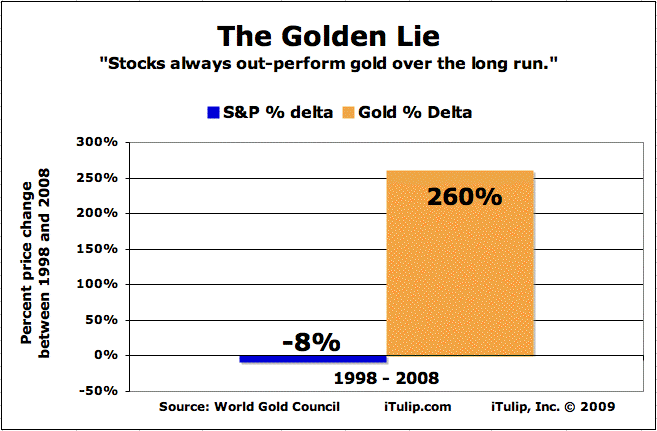
Over the past ten years, thousands of Ivy League university trained money mangers, schooled in the “science” of modern portfolio theory, spent in aggregate hundreds of thousands of hours analyzing the stock market, rotating holdings from one sector to another, carefully selecting entry and exit points to maximize returns, costing tens of billions in fees, all to try to beat the horrid -8% nominal return of the S&P index over that period. Still few were able to mimic the 260% return on gold they could have earned if they bought gold at the start of each year since 1998 and then did nothing at all.
Readers need no more than the one chart above to measure the scale of the disaster that FIRE Economy political and economic policies have brought us: two massive asset bubbles and a mountain of unpayable private and public sector debt. Rescue efforts after the latest crash have so far produced the grim monstrosity of nationalized GSEs, Government Motors, further concentration of money and power in America’s financial institutions, and a multi-trillion dollar gamble of the nation’s sovereign credit that housing prices can be re-inflated and credit-financed consumer spending restarted.
Don’t hold your breath waiting for a devaluation of the dollar. As I have said a dozen times before, the U.S. will never, ever explicitly devalue the dollar. Since the floating exchange rate system began in the early 1970s, no net debtor nation has ever explicitly devalued. To do so is to trigger a sovereign credit crisis. Since the 1970s, such devaluations have only ever been announced after a credit default had already occurred.
Net debtors don’t have to devalue; currency depreciation is a natural result of fiscal deficits, in combination with other factors. For a net debtor, the challenge comes in the other direction. How to maintain the exchange rate value of the currency in the face of massive fiscal deficits if the economy does not develop self-sustained, organic growth?
Readers need no more than the one chart above to measure the scale of the disaster that FIRE Economy political and economic policies have brought us: two massive asset bubbles and a mountain of unpayable private and public sector debt. Rescue efforts after the latest crash have so far produced the grim monstrosity of nationalized GSEs, Government Motors, further concentration of money and power in America’s financial institutions, and a multi-trillion dollar gamble of the nation’s sovereign credit that housing prices can be re-inflated and credit-financed consumer spending restarted.
Don’t hold your breath waiting for a devaluation of the dollar. As I have said a dozen times before, the U.S. will never, ever explicitly devalue the dollar. Since the floating exchange rate system began in the early 1970s, no net debtor nation has ever explicitly devalued. To do so is to trigger a sovereign credit crisis. Since the 1970s, such devaluations have only ever been announced after a credit default had already occurred.
Net debtors don’t have to devalue; currency depreciation is a natural result of fiscal deficits, in combination with other factors. For a net debtor, the challenge comes in the other direction. How to maintain the exchange rate value of the currency in the face of massive fiscal deficits if the economy does not develop self-sustained, organic growth?
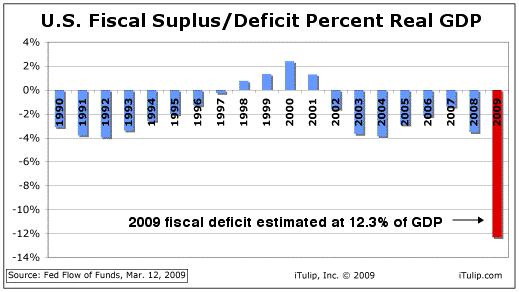
The U.S. spends and spends to try to “stimulate” the economy
(read: expand public debt) until it grows on its own (read: private debt expands)
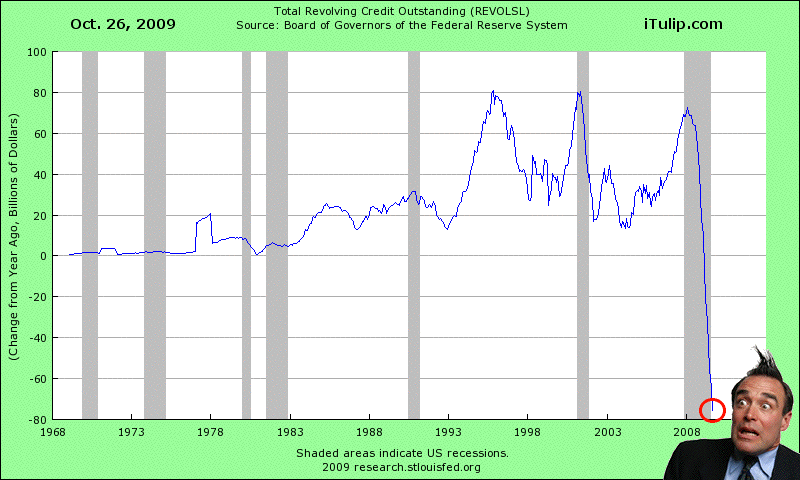
Yet consumer credit continues to decline
What if the U.S. runs out of sovereign credit before the consumer starts going back into debt?
If that happens we get currency event that we have warned since 1999 may be the eventual payback for decades of FIRE Economy policies. And if that happens not only will gold rise even more than it has nearly every year for the past decade, it will rise to the $2500 to $5000 range that we have forecast since 2001 sooner than later.
See also: What Gold Bubble? - Janszen Oct. 2006
Economic and market forecasting in a post-bubble world ($ubscription)
Last night I attended a private event in Boston where Jeremy Grantham spoke to an audience of about 30 for an hour. As a fellow asset bubble watcher for more than a decade, he faces similar challenges now that the bubble era is over and a new era of uncertainty has begun. These are my comments on some of the key points that he made.
I read Grantham’s superb newsletters six months to a year after they are published. In fact, I don’t read anyone’s market and economic forecasts until they are at least half a year old. That may strike some readers as odd but there’s a method to the madness. If I stick to my own primary research and analysis then readers can be certain that if my analysis agrees with others' it’s because I have reached the same conclusions independently.
Grantham comes across in person as brilliant, honest, self-critical, and hyper-competitive. These are great qualities for a fund manager. I got the impression that he’d make a very, very demanding boss who does not suffer fools.
He contested his reputation as a perma-bear. As a point in fact he recalled his March 2009 special issue newsletter that appeared on the GMO web site on the very day that the S&P bottomed. Back when I was warning readers “beware relief rallies” he was saying “buy, buy, buy” but don’t expect the rally to reflect fundamentals. more... ($ubscription)
iTulip Select: The Investment Thesis for the Next Cycle™
__________________________________________________
To receive the iTulip Newsletter or iTulip Alerts, Join our FREE Email Mailing List
Copyright © iTulip, Inc. 1998 - 2009 All Rights Reserved
All information provided "as is" for informational purposes only, not intended for trading purposes or advice. Nothing appearing on this website should be considered a recommendation to buy or to sell any security or related financial instrument. iTulip, Inc. is not liable for any informational errors, incompleteness, or delays, or for any actions taken in reliance on information contained herein. Full Disclaimer
If that happens we get currency event that we have warned since 1999 may be the eventual payback for decades of FIRE Economy policies. And if that happens not only will gold rise even more than it has nearly every year for the past decade, it will rise to the $2500 to $5000 range that we have forecast since 2001 sooner than later.
See also: What Gold Bubble? - Janszen Oct. 2006
 |
Last night I attended a private event in Boston where Jeremy Grantham spoke to an audience of about 30 for an hour. As a fellow asset bubble watcher for more than a decade, he faces similar challenges now that the bubble era is over and a new era of uncertainty has begun. These are my comments on some of the key points that he made.
I read Grantham’s superb newsletters six months to a year after they are published. In fact, I don’t read anyone’s market and economic forecasts until they are at least half a year old. That may strike some readers as odd but there’s a method to the madness. If I stick to my own primary research and analysis then readers can be certain that if my analysis agrees with others' it’s because I have reached the same conclusions independently.
Grantham comes across in person as brilliant, honest, self-critical, and hyper-competitive. These are great qualities for a fund manager. I got the impression that he’d make a very, very demanding boss who does not suffer fools.
He contested his reputation as a perma-bear. As a point in fact he recalled his March 2009 special issue newsletter that appeared on the GMO web site on the very day that the S&P bottomed. Back when I was warning readers “beware relief rallies” he was saying “buy, buy, buy” but don’t expect the rally to reflect fundamentals. more... ($ubscription)
iTulip Select: The Investment Thesis for the Next Cycle™
__________________________________________________
To receive the iTulip Newsletter or iTulip Alerts, Join our FREE Email Mailing List
Copyright © iTulip, Inc. 1998 - 2009 All Rights Reserved
All information provided "as is" for informational purposes only, not intended for trading purposes or advice. Nothing appearing on this website should be considered a recommendation to buy or to sell any security or related financial instrument. iTulip, Inc. is not liable for any informational errors, incompleteness, or delays, or for any actions taken in reliance on information contained herein. Full Disclaimer
 does give one pause I'll admit regarding the fragility of the stock market
does give one pause I'll admit regarding the fragility of the stock market
 ]
]
Comment